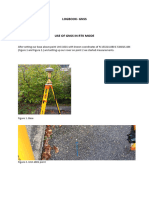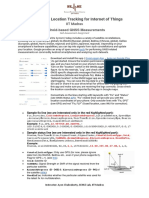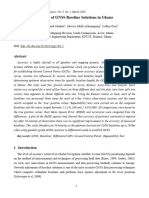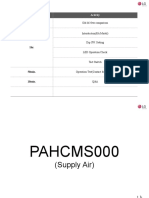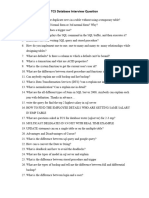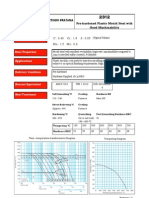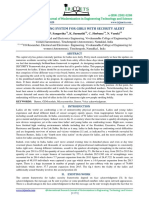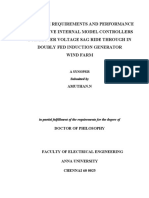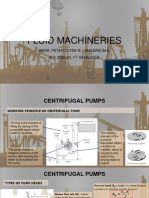GNSS Processing Report
Geomorphology
Name: Allison Soria
Introduction.
GNSS (Global Navigation Satellite System) processing using Trimble involves several key stages.
First, satellite masking is performed, which filters out signals from satellites below a certain elevation
angle to avoid interference and improve accuracy. Next, baseline processing is conducted, which
calculates the distances between fixed and mobile GNSS stations to determine precise positions. This
method is essential in applications such as surveying and geodesy, where accuracy is crucial. Trimble
provides advanced tools to manage and optimize these processes, ensuring reliable and accurate
results.
Methodology.
For the analysis, points from the raw data folder dated December 6, 2023, were used. These data were
downloaded from the Pimampiro geoportal (PIEC) and included six reference points labeled A001 to
A006 in Puntos.xlsx
Baseline Processing Configuration:
● Processing Section: Set an interval of 5 seconds and select both fixed and float solutions.
● Quality Section: Define acceptance criteria as follows:
○ Horizontal solutions accepted at 0.005 meters + 1 ppm.
○ Failed solutions at 0.01 meters + 2 ppm.
○ Vertical solutions accepted at 0.01 meters + 2 ppm.
○ Failed vertical solutions at 0.02 meters + 4 ppm.
Download Base Data:
● Download base data from the corresponding geoportal for December 6, 2023.
Download Precise Ephemeris (Satellite Positions):
● Final (13 days).
● Rapid (17 hours).
● Ultra-rapid (3–9 hours).
Ephemeris Configuration:
● Download the file for the survey day, as well as one day before and one day after.
● Work with the data from the specific survey day.
Baseline Selection:
● Select the baseline.
● Verify satellite availability for observations.
● Proceed to mask satellite losses.
The type of solutions that are obtained during the calculation of the positions are:
� - Fixed solutions, the software has successfully resolved GNSS phase ambiguities. Therefore
the solution is more precise, because the coordinates have been measured exactly, so the
horizontal and vertical accuracy values are usually very low, which is a good sign.
- Floating solutions, the software fails to fully resolve the phase ambiguities of GNSS signals.
Instead of fixing the integer values, the software estimates them as fractions, resulting in
decreased accuracy.
The acceptance criteria were:
○ Fixed solution: 0.005 meters + 1 ppm.
○ Floating solution: 0.01 meters + 2 ppm.
These configurations ensure that the software can provide the best possible solution based on the
conditions of the data collected.
Results.
- The points named a001, a003, a006, a007, a009 were of good quality with low interference
and with sufficient visible satellites as can be seen in table 1.
- The point named a002, a005 and a008 solution is failed because the team did not cover the
minimum time needed to get a fixed solution, so, the software failed to calculate the baseline
and the second point.
- Point a004 had a high error in horizontal accuracy with 4.719 and horizontal accuracy of
5.778.
Table 1. Processing summary.
Observation.
- The flags shown in Appendix 1 show point a001 exceed the limits set by the software settings
for vertical tolerance, therefore, it cannot be considered reliable.
- Points a001 and a007 are out of tolerance on both the vertical and horizontal axes, indicating
significant errors in measurements. The baselines between PIEC_6dic2023 and the points
mentioned have not reached the necessary precision to be considered within the acceptable
criteria set out in the software.
- Points a007 and a008 are farther away from each other, suggesting that the baselines
connecting them to the other points are longer. Longer distances may be more subject to
errors or issues related to GNSS signal quality due to atmospheric factors.
� - Point a004 High error in horizontal accuracy (4.719 and 5.778). It requires review and
possible data collection under better conditions.
Conclusion.
In conclusion, when analysing the GNSS solutions for points a001 to a009, a significant variability in
the accuracy of the measurements is evidenced, especially between the "fixed" and "float" solutions.
Points a001, a003, a005, a007 and a009 demonstrate a stability and accuracy that makes them suitable
for applications in geology, which is critical in our field. However, points a002, a004 and a006
present float solutions, which indicates that we must review the conditions under which the
measurements were made. Point a004 stands out for its high error in horizontal accuracy, underlining
the need to carry out measurements in optimal environments and with properly calibrated equipment.
To ensure that the data are reliable and useful for our geological investigations, it is crucial to improve
our collection methods and, if possible, repeat observations under better conditions.
Annexes
Anexo 1. Flags Windows
- Folder in One Drive: Midterm_AllisonSoria
- Dates and code of the points used: Puntos.xlsx
- The adjustment pdf file: Baseline Processing Report_Soria_Perero_Allison.pdf









